 Werner Keym is one of the most creative problemists I know. He specializes in problems involving castling, en passant captures and pawn promotion. For many years I have enjoyed his problems, which I often encountered. I also enjoyed his chess humour. And his meticulous quest for accuracy.
Werner Keym is one of the most creative problemists I know. He specializes in problems involving castling, en passant captures and pawn promotion. For many years I have enjoyed his problems, which I often encountered. I also enjoyed his chess humour. And his meticulous quest for accuracy.
Currently Werner Keym is working on a book on chess classics – in over-the-board play, but also in studies and chess problems. A "classic," as defined in the preface, is a game, study, a mating or winning combination, a problem, or an idea expressed on the chessboard, that is of note, and is striking for excellence or originality, or historically famous. The first part of his book contains ten classic games and 165 studies and different types of problems – the second half consists of 175 extraordinary problems, for which he is a leading specialist. The book is in English, and I am helping with comments and suggestions, and with proof-reading. In return for this "service" I will be allowed to show you some of the examples Werner has selected, together with his notes and comments. I will also tell you when the book is available and how it can be ordered.
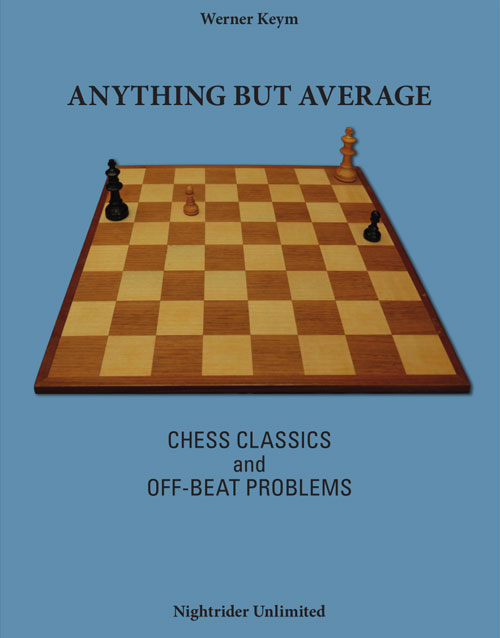 Werner Keym: Anything but Average – Chess Classics and Off-beat Problems, is aimed at all chess lovers: players and problemists. Immortal games by Anderssen, Fischer, Kasparov, Carlsen, famous endgame studies by Barbier-Saavedra, Lasker, Troitzky, Réti etc. and classical problems of all kinds are presented and explained with additional diagrams, moreover 24 top problems elected as ‘Millennium Problems’ in 2000 and special compositions with asymmetry, castling and promotion. The book has viii + 190 pages, 375 games, studies, problems, puzzles by 240 authors, 120 related problems, 180 additional diagrams. English text. Paperback: 10 € + postage, order per e-mail: Ralf.Kraetschmer@t-online.de.
Werner Keym: Anything but Average – Chess Classics and Off-beat Problems, is aimed at all chess lovers: players and problemists. Immortal games by Anderssen, Fischer, Kasparov, Carlsen, famous endgame studies by Barbier-Saavedra, Lasker, Troitzky, Réti etc. and classical problems of all kinds are presented and explained with additional diagrams, moreover 24 top problems elected as ‘Millennium Problems’ in 2000 and special compositions with asymmetry, castling and promotion. The book has viii + 190 pages, 375 games, studies, problems, puzzles by 240 authors, 120 related problems, 180 additional diagrams. English text. Paperback: 10 € + postage, order per e-mail: Ralf.Kraetschmer@t-online.de.
Analyse the classics
Today I will start with three games that were selected as all-time classics. Two of them will certainly be known to the majority of our readers, but I want to add a new twist: I think we should all look at them again, more carefully, with computer assistance. And that is made trivially simple by the JavaScript replay board on our news pages. You can, without further ado, move pieces, try alternate lines of play, see what the engine thinks of them. Full instructions on how to use the player are given after the first game.
The Immortal Game
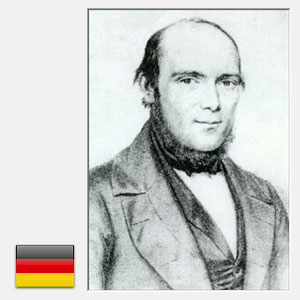
 No. 1: Anderssen – Kieseritzky, London 1851
No. 1: Anderssen – Kieseritzky, London 1851
Adolf Anderssen (1818-78) was regarded as the world chess champion of his era, although that title did not yet exist officially. Lionel Adalbert Bagration Felix Kieseritzky (1806-53) invented a line in the King’s Gambit.

[Event "London"] [Site "?"] [Date "1851.??.??"] [Round "?"] [White "Anderssen, Adolf"] [Black "Kieseritzky, Lionel"] [Result "1-0"] [ECO "C33"] [Annotator "Werner Keym"] [PlyCount "45"] [EventDate "1851.??.??"] [SourceVersionDate "2020.02.19"] 1. e4 e5 2. f4 exf4 3. Bc4 Qh4+ 4. Kf1 b5 5. Bxb5 Nf6 6. Nf3 Qh6 7. d3 Nh5 8. Nh4 Qg5 9. Nf5 c6 10. Rg1 cxb5 11. g4 Nf6 12. h4 Qg6 13. h5 Qg5 14. Qf3 Ng8 15. Bxf4 Qf6 16. Nc3 Bc5 17. Nd5 Qxb2 {[#]} 18. Bd6 $3 {A brilliant move.} Qxa1+ { First rook sacrifice} 19. Ke2 {[#]} Bxg1 $2 {The second rook sacrifice.} ({ Much better is} 19... Qb2 $1) 20. e5 $3 {This blocks off the black queen.} Na6 21. Nxg7+ Kd8 22. Qf6+ $1 Nxf6 {A queen sacrifice.} 23. Be7# {[#] All black officers are still on the board. However, White has sacrificed his bishop, his rooks and his queen to gain much time and to finish with a checkmate by his three remaining minor pieces.} 1-0
Analysing in the replay window
You probably know that in our replay boards there are a large number of new functions you can use to really appreciate the games. Recently we published a comprehensive tutorial on how to get the most out of the live broadcast game viewer. Learn about all the powerful features and buttons that make the ChessBase's replay one of the best watching experiences around.
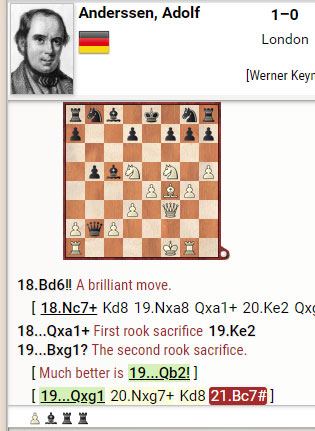 In the above absolute classic you might wonder if 18.Bd6!! was the only move for Anderssen to win the game, albeit it brilliantly. You may want to try 18.Nc7+ instead, something the board engine also thinks is promising (2.01 pawns).
In the above absolute classic you might wonder if 18.Bd6!! was the only move for Anderssen to win the game, albeit it brilliantly. You may want to try 18.Nc7+ instead, something the board engine also thinks is promising (2.01 pawns).
But if you are simply going for 18.Nc7+ Kd8 19. Nxa8 then 19...Qxa1 20.Ke2 Qxg1 gives Black an engine advantage of –5.15 pawns – a mating net is no longer availble to White.
Note that your analysis, where you can delete, move or promote lines, is stored in the notation as new variations. In the end you will find the game with your analysis in the cloud (see instructions mention above). So nothing is ever lost.

Here you can see that the engine wants to play 19.Re1 or 19.Rd1 after 18...Kd8 – you can get multiple lines of analysis by clicking the + button to the right of the engine analysis window. The ! key, incidentally, shows you the threat in any position, which is incredibly useful in the case of unclear moves.
 There is one more thing you can do that is a lot of fun: Clicking on the rook icon below the notation window allows you to play out any position in the game against Fritz, at your level of playing strength (e.g. "Club Player").
There is one more thing you can do that is a lot of fun: Clicking on the rook icon below the notation window allows you to play out any position in the game against Fritz, at your level of playing strength (e.g. "Club Player").
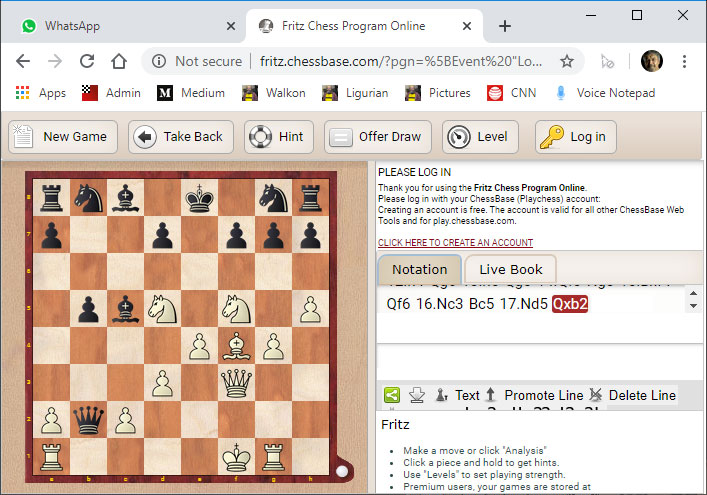
A new window appears, with the position on the board, and all the functionality of a chess playing program. Try to win the position with a different continuation. But careful, in dynamic positions this function is addictive, you can spend a lot of time playing it out against Fritz.
So, equipped with the analysis functions of the replay board we invite you to look at two more classical games from Werner Keym's book. You have probably seen them before, but have you checked out all the fine points of the moves that were played?
The Immortal Draw
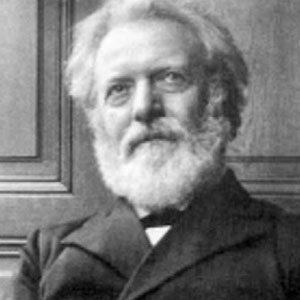
 No. 2: Hamppe – Meitner, Vienna 1872
No. 2: Hamppe – Meitner, Vienna 1872
Carl Hamppe (1814-76) and Philipp Meitner (1838-1910) were prominent players of the Vienna school. Hamppe enriched the theory of the King’s Gambit and the Vienna Game.
[Event "Vienna"] [Site "?"] [Date "1872.??.??"] [Round "?"] [White "Hamppe, Carl"] [Black "Meitner, Philipp"] [Result "1/2-1/2"] [ECO "C25"] [Annotator "Werner Keym"] [PlyCount "36"] [EventDate "1872.??.??"] [SourceVersionDate "2020.02.19"] 1. e4 e5 2. Nc3 Bc5 3. Na4 $2 {A premature move.} Bxf2+ {In the 19th century romantic style.} 4. Kxf2 Qh4+ 5. Ke3 Qf4+ 6. Kd3 d5 7. Kc3 Qxe4 8. Kb3 Na6 {[#] } 9. a3 $2 ({Much better is} 9. d4 $1 exd4 10. Bxa6 bxa6 11. Nc5) 9... Qxa4+ { A spectacular queen sacrifice.} 10. Kxa4 Nc5+ 11. Kb4 a5+ 12. Kxc5 Ne7 13. Bb5+ Kd8 {Threatening b6#.} 14. Bc6 b6+ 15. Kb5 Nxc6 16. Kxc6 Bb7+ 17. Kb5 $1 (17. Kxb7 $2 Kd7 18. Qg4+ Kd6 19. Qd7+ Kxd7 {18. any, Rhb8#.}) 17... Ba6+ 18. Kc6 ( 18. Ka4 $2 Bc4 {19. any, b5#}) 18... Bb7+ {[#] and draw by repetition. This game is famous for the lengthy king’s walk and the final moves which result in an unexpected draw.} 1/2-1/2
For good reason a win in a game or endgame study is more exciting than a draw. That is why among the classical games and endgame studies there are not many drawn ones.
The Floating Rook
No. 3: Steinitz – von Bardeleben Hastings 1895
Wilhelm Steinitz (1836-1900) was the first official world chess champion (1886-94). Curt von Bardeleben (1861-1924) was a strong, but unstable chess player.

[Event "Hastings"] [Site "?"] [Date "1895.??.??"] [Round "?"] [White "Steinitz, Wilhelm"] [Black "von Bardeleben, Curt"] [Result "1-0"] [ECO "C54"] [Annotator "Werner Keym"] [PlyCount "49"] [EventDate "1895.??.??"] [SourceVersionDate "2020.02.19"] 1. e4 e5 2. Nf3 Nc6 3. Bc4 Bc5 4. c3 Nf6 5. d4 exd4 6. cxd4 Bb4+ 7. Nc3 d5 8. exd5 Nxd5 9. O-O Be6 10. Bg5 Be7 11. Bxd5 Bxd5 12. Nxd5 Qxd5 13. Bxe7 Nxe7 14. Re1 f6 15. Qe2 Qd7 16. Rac1 c6 $2 17. d5 $3 {[#] A clever pawn sacrifice.} cxd5 18. Nd4 {An excellent place for the knight.} Kf7 19. Ne6 Rhc8 20. Qg4 $1 g6 21. Ng5+ $1 Ke8 22. Rxe7+ $3 Kf8 $1 {[#] All four White officers are attacked and unguarded.} 23. Rf7+ $1 {Starting one of the most famous sequences of sacrificial offers in chess history.} Kg8 (23... Qxf7 $2 24. Rxc8+ Rxc8 25. Qxc8+ Qe8 26. Nxh7+) 24. Rg7+ Kh8 25. Rxh7+ $1 ({Von Bardeleben got up and left the tournament hall, because he did not want to see what would have followed:} 25. Rxh7+ Kg8 26. Rg7+ Kh8 27. Qh4+ Kxg7 28. Qh7+ Kf8 29. Qh8+ Ke7 30. Qg7+ Ke8 (30... Kd8 31. Qf8+ Qe8 32. Nf7+ Kd7 33. Qd6# {[#]}) 31. Qg8+ Ke7 32. Qf7+ Kd8 33. Qf8+ Qe8 34. Nf7+ Kd7 35. Qd6#) 1-0
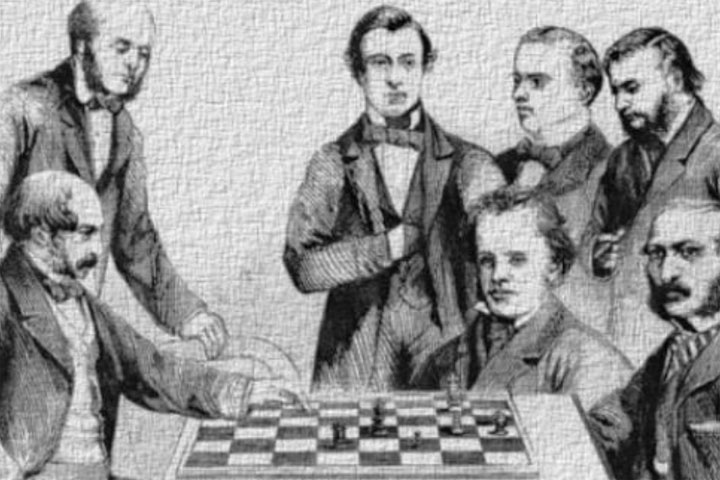

















 Werner Keym is one of the most creative problemists I know. He specializes in problems involving castling, en passant captures and pawn promotion. For many years I have enjoyed his problems, which I often encountered. I also enjoyed his chess humour. And his meticulous quest for accuracy.
Werner Keym is one of the most creative problemists I know. He specializes in problems involving castling, en passant captures and pawn promotion. For many years I have enjoyed his problems, which I often encountered. I also enjoyed his chess humour. And his meticulous quest for accuracy. Werner Keym: Anything but Average – Chess Classics and Off-beat Problems, is aimed at all chess lovers: players and problemists. Immortal games by Anderssen, Fischer, Kasparov, Carlsen, famous endgame studies by Barbier-Saavedra, Lasker, Troitzky, Réti etc. and classical problems of all kinds are presented and explained with additional diagrams, moreover 24 top problems elected as ‘Millennium Problems’ in 2000 and special compositions with asymmetry, castling and promotion. The book has viii + 190 pages, 375 games, studies, problems, puzzles by 240 authors, 120 related problems, 180 additional diagrams. English text. Paperback: 10 € + postage, order per e-mail:
Werner Keym: Anything but Average – Chess Classics and Off-beat Problems, is aimed at all chess lovers: players and problemists. Immortal games by Anderssen, Fischer, Kasparov, Carlsen, famous endgame studies by Barbier-Saavedra, Lasker, Troitzky, Réti etc. and classical problems of all kinds are presented and explained with additional diagrams, moreover 24 top problems elected as ‘Millennium Problems’ in 2000 and special compositions with asymmetry, castling and promotion. The book has viii + 190 pages, 375 games, studies, problems, puzzles by 240 authors, 120 related problems, 180 additional diagrams. English text. Paperback: 10 € + postage, order per e-mail: 
 No. 1: Anderssen – Kieseritzky, London 1851
No. 1: Anderssen – Kieseritzky, London 1851
 In the above absolute classic you might wonder if 18.Bd6!! was the only move for Anderssen to win the game, albeit it brilliantly. You may want to try 18.Nc7+ instead, something the board engine also thinks is promising (2.01 pawns).
In the above absolute classic you might wonder if 18.Bd6!! was the only move for Anderssen to win the game, albeit it brilliantly. You may want to try 18.Nc7+ instead, something the board engine also thinks is promising (2.01 pawns).
 There is one more thing you can do that is a lot of fun: Clicking on the rook icon below the notation window allows you to play out any position in the game against Fritz, at your level of playing strength (e.g. "Club Player").
There is one more thing you can do that is a lot of fun: Clicking on the rook icon below the notation window allows you to play out any position in the game against Fritz, at your level of playing strength (e.g. "Club Player").

 No. 2: Hamppe – Meitner, Vienna 1872
No. 2: Hamppe – Meitner, Vienna 1872




